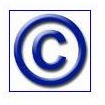Difference Between a Copyright and a Trademark: Which One Do You Need?
Purpose of Obtaining Protection
The purpose of a copyright or trademark (or patent, for that matter) is to protect intellectual property. Intellectual property is a term used to describe diverse creations people craft, fashion, form, or imagine (and write down), including works of art, logos, images, and literary and artistic creations.
Which Protection Should I Choose?
It’s important to distinguish between copyrights and trademarks, so that you can select the right option for you.
Copyrights protect and are granted to individuals (or groups of individuals) who create something new and unique, such as a book, song, or artistic work of art. Web pages, research papers, poems, and photographs can be copyrighted as well. A copyright can only be applied to an original work of creative expression. You cannot obtain a copyright for an idea, method, a non-unique lists of items, the alphabet, or any other work that you yourself did not create.
Trademarks are not unique, never-before-thought-of works of expressions. Trademarks are words, names, symbols, logos, and the like that are used by companies to distinguish their brand. While a trademark does protect a brand though, it does not protect another person from creating the same product (only a patent can protect that). You may want to refer to The Difference Between a Patent and a Trademark if you aren’t sure.
Summary
Important points to remember:
- Copyrights protect the authors and creators of tangible, original works of art. The work can be copied, reproduced, and/or held in ones hands. Trademarks most often protect a company name, logo, or brand, which are most often stamped or printed on the product or product packaging to identify the product.
- Copyrights protect and are granted for original works of art, like sculptures and books. Trademarks protect and are granted for logos, slogans, and short phrases (even if they are common ones).
- Copyright protection requires a small fee and is processed quickly. There are several steps to obtaining a copyright, see The Steps Involved in Applying for a Copyright. Trademark protection costs more and takes more time to process.
- There is software to assist you in obtaining your copyright, one is Webweaver’s Copyright Generator.
References
- This article was written by Joli Ballew and she created the graphics shown. It is the author’s experience that both copyrights and trademarks are important to obtain, even if you’re not sure your creation will ever become mainstream or popular. It’s always best to be protected, but you just never know!
